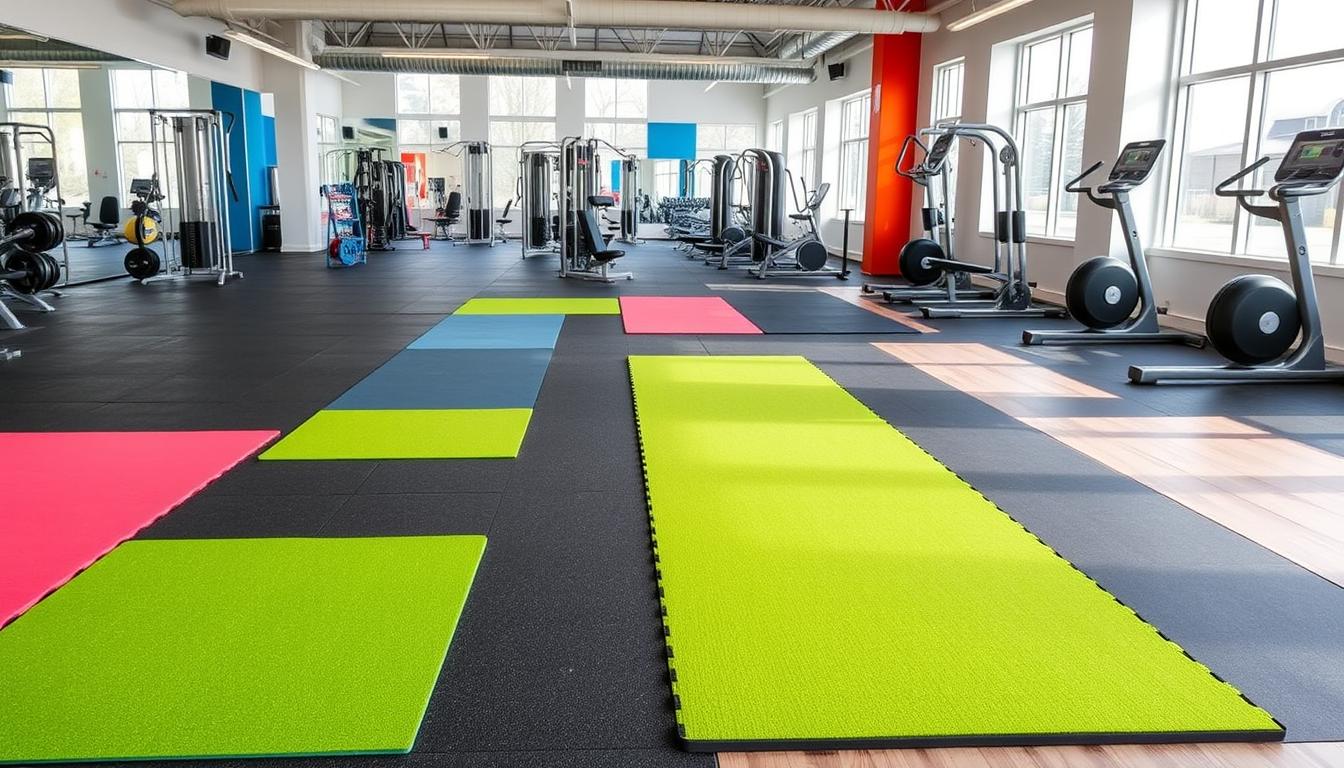Top Workout Schedule : As I put on my sneakers and stepped out into the crisp morning air, I felt a new sense of purpose. My journey to get healthy had ups and downs, but today was a fresh start. I was set to change my fitness with a solid workout plan. Let’s explore how to create a great workout routine that boosts your energy and helps you reach your goals.
The Centers for Disease Control and Prevention (CDC) say adults should do at least 150 minutes of moderate exercise weekly. That’s 30 minutes a day, five days a week. They also suggest two days of muscle-strengthening activities each week. With a mix of cardio and strength training, you’ll unlock your full potential and live a healthier life.
Table of Contents
Understanding the Importance of a Workout Schedule
Creating a structured workout regimen can change your fitness journey. A good workout schedule gives you direction. It also makes sure you use key strategies to reach your goals.
Benefits of a Structured Approach
A consistent training program balances different types of exercises. This balance improves your fitness, muscle strength, and heart health.
How it Affects Consistency
Following a fitness schedule deeply impacts your progress. It leads to better sleep, brainpower, and happiness. Also, mixing up your workouts prevents plateaus and injuries.

“A well-designed workout schedule not only provides direction but also ensures you incorporate essential strategies to achieve your desired results.”
Finding a workout regimen that fits your goals and lifestyle is key. Understanding the benefits of structure and consistency helps you start improving your fitness.
Key Components of an Effective Workout Schedule
Making a good workout schedule is key to reaching your fitness goals. You might want to build muscle, get your heart rate up, or just feel better. Your routine should include three main parts: strength training, cardio, and stretching.
Resistance Training
Strength training is vital for any good gym plan. It helps you build muscle, speed up your metabolism, and strengthen bones. Try to do strength training two to three times a week. Make sure to work out all the big muscle groups.
Cardiovascular Workouts
Cardio is important for your heart and stamina. It can be running, cycling, or swimming. For losing weight or staying fit, do 20 to 60 minutes of cardio five times a week. Mix up your routines to keep things interesting.
Flexibility and Mobility
Adding stretching and mobility to your routine is also important. It makes you more flexible and helps prevent injuries. Try stretching, yoga, or foam rolling to improve your flexibility and help your body recover.
By mixing these three parts, you can make a workout plan that really works. Start slow, increase your effort and time gradually, and pay attention to your body. This way, you can avoid getting too tired.

Defining Your Fitness Goals
Top Workout Schedule : Starting a fitness journey begins with setting goals. First, check where you are now and what you want to achieve. This helps make a plan that fits your needs and dreams. It makes sure your workouts are effective.
Assessing Your Current Fitness Level
Top Workout Schedule : Before starting, know where you begin. Get help from a health expert to find your fitness baseline. This might include tests like your heart rate after walking a mile or how many push-ups you can do.
Knowing where you start helps pick the right level of workouts. Everyone starts differently. Focus on your own growth, not comparing with others.
Setting SMART Goals
Top Workout Schedule : After knowing your starting point, set SMART goals. These goals are specific, measurable, achievable, relevant, and have a deadline. For example, if you want to lose weight, aim for 20-60 minutes of cardio, 5 times a week. For building muscle, focus on getting stronger over time.
Use the perceived exertion scale or the talk test to check your workout’s intensity. Tracking your progress and adjusting your plan keeps you motivated and on track.

“Setting specific, measurable goals is crucial for success in any fitness plan. By clearly defining what you want to accomplish, you can create a roadmap to guide your progress and stay motivated along the way.”
With a good understanding of your current fitness and clear goals, you’re ready to improve. You’ll reach new heights in your exercise and training.
Types of Workout Schedules
Top Workout Schedule : Choosing the right workout schedule is crucial for reaching your fitness goals. Whether you’re new to the gym or have been going for years, knowing your options can help you find the best fit. Let’s look at the different types of workout schedules and their benefits.
Weekly Split Routine
Top Workout Schedule : A weekly split routine divides your workouts by muscle groups. This lets you focus on specific areas of your body each day. For example, you might have days for your chest and triceps, back and biceps, and legs. This way, you give each muscle group the attention it needs.
Full-Body Workouts
Top Workout Schedule : Full-body workouts, on the other hand, target all major muscle groups in one session. They’re great for beginners because they build strength and balance. They’re also good for those with busy schedules, as they work out multiple areas in one go.
Hybrid Schedules
Top Workout Schedule : Hybrid schedules mix different workout types. You might do full-body workouts and split routines, or switch between strength training and HIIT. This approach offers a balanced fitness plan by combining various training styles.
Consistency is essential, no matter the schedule you choose. Using workout regimens, gym schedules, and workout calendars can keep you on track. This helps you reach your fitness goals.

Designing Your Own Top Workout Schedule
Making a good workout schedule is key to getting fit. It doesn’t matter if you’re just starting out or have been working out for years. A schedule that fits you can help you reach your fitness goals and stay on track. Let’s look at what you need to think about when making your workout plan.
Frequency and Duration of Workouts
Top Workout Schedule :How often and how long you work out matters a lot. Experts say you should aim for 3 to 5 workouts a week for the best results. Beginners might start with 2-3 cardio days and 2 strength training days. Intermediate folks might do 3-5 days of both, while advanced exercisers could try 5-6 days with different types of workouts.
How long you work out can change based on your fitness level and what you want to achieve. Even short workouts, like just one minute, can be good for your heart and reduce sitting time. But, to really build muscle and get fit, you should aim for at least 30 minutes a day.
Sample Weekly Layout
Having a weekly workout plan can keep you on track and help you see progress. Here’s a simple example:
- Monday: Lower Body Strength Training (60 minutes)
- Tuesday: Cardio (30-45 minutes)
- Wednesday: Rest or Active Recovery (yoga, stretching)
- Thursday: Upper Body Strength Training (60 minutes)
- Friday: Cardio (30-45 minutes)
- Saturday: Full-Body Strength Training (60 minutes)
- Sunday: Rest
Your schedule should fit your fitness level, goals, and life. Change the frequency, length, and type of workouts as you need to for the best recovery and progress.

By planning your workouts carefully, you can make a routine that works for you. This routine can help you get fit and reach your goals.
Integrating Strength and Cardio Workouts
Getting a balanced fitness routine is key for good health and performance. Mixing strength and cardio workouts boosts your fitness levels. It’s all about finding the right mix of these two important parts of exercise.
Balancing Strength and Cardio
Experts say do strength training at least twice a week to keep muscles and bones strong. The CDC also recommends 150 minutes of moderate aerobic activity or 75 minutes of vigorous activity weekly for heart health. Aim to split your workouts to include both strength and cardio.
Choosing the Right Exercises
For strength training, choose compound exercises like deadlifts, squats, and bench presses. These work many muscles at once. For cardio, pick activities like running, cycling, or swimming that raise your heart rate and test your endurance. Always warm up with dynamic stretching to avoid injuries and boost flexibility.
Mixing strength and cardio in your workout plan can lead to better body shape, more strength, and overall fitness. Make your exercise plan fit your goals, fitness level, and likes for lasting success.
“A personalized workout plan can help individuals achieve fitness goals while considering their medical history.” – Alliance Orthopedics
Combining strength and cardio workouts is a smart way to elevate your fitness. With the right mix and choices, you can reach your fitness goals and improve your health and well-being.
Importance of Recovery in Your Schedule
Reaching your fitness goals isn’t just about hard workouts. Recovery is key for your body’s repair and growth. It’s vital to give your muscles time to rest and recover between intense sessions. This helps keep your fitness schedule going strong over time.
Active Recovery Techniques
Don’t skip a day completely. Add active recovery to your routine. This means doing light, easy activities to help your muscles heal. Good active recovery methods include:
- Walking or hiking
- Swimming or cycling
- Gentle yoga or stretching
- Foam rolling and self-myofascial release
These activities ease muscle tightness, lessen soreness, and get you ready for harder workouts.
Signs You Need More Rest
It’s important to listen to your body to avoid overtraining. Look out for these signs you might need more rest:
- Persistent muscle soreness or fatigue
- Decreased performance or stamina during workouts
- Difficulty sleeping or poor sleep quality
- Increased susceptibility to injury or illness
If you see these signs, it’s time to adjust your fitness plan. Add more rest days or make your workouts less intense. Giving your body enough rest is crucial for reaching your fitness goals.
By using active recovery and listening to your body, you can make your workout plan better. This helps you make steady progress in your fitness journey.
Nutrition and Hydration in Your Workout Plan
Proper nutrition and hydration are key for a good gym schedule, workout calendar, and exercise timetable. Eating the right foods before and after working out boosts your performance. It also helps your muscles recover.
Pre-Workout Nutrition Tips
Before your exercise timetable, eat carbs and protein that are easy to digest. Carbs give your muscles the energy they need. Protein helps fix and grow muscle. Eat big meals 3 to 4 hours before, or smaller ones 1 to 3 hours before.
Post-Workout Recovery Meals
After your workout calendar, refuel with carbs and protein. Carbs fill up your energy stores. Protein fixes and grows muscles. Eating these within two hours of working out is key for recovery.
Also, drinking water is vital before, during, and after your gym schedule. Drink 2 to 3 cups of water before, 1/2 to 1 cup every 15 to 20 minutes during, and 2 to 3 cups after for every pound lost.
By focusing on good nutrition and hydration in your exercise timetable, you’ll get the most out of your workouts. You’ll see better results too.
Tracking Your Progress
Keeping track of your progress is key to reaching your fitness goals. By monitoring your workouts, you can make changes to keep challenging yourself. This helps you stay on track to meet your objectives.
Tools for Monitoring Your Workouts
There are many tools to help you track your fitness. Apps like MyFitnessPal, Fitbit, and Strava let you log your workouts. They also track your progress over time. Wearable devices like smartwatches and fitness trackers capture important health data like heart rate and steps.
Keeping a workout journal is also helpful. It lets you record your exercises and progress. Taking progress photos and tracking body measurements can show your physical changes.
Adjusting Your Schedule Based on Results
Check your progress data often to see where you can improve. If you’re not getting the results you want, it might be time to change your workout routine. Celebrate your achievements, big or small, to stay motivated.
By tracking your progress and adjusting your workouts based on data, you’ll keep your fitness journey exciting and rewarding.
Staying Motivated to Stick to Your Schedule
Keeping motivated is essential to make your fitness goals a lasting habit. Whether you want to boost your exercise plans or change your training programs, it’s important to stay excited about your journey. Finding ways to keep you engaged is crucial.
Find a Workout Buddy
Working out with a friend or joining a group class can give you the support and fun you need. The shared experience and encouragement can make workouts more fun. It also helps you stay motivated when you feel like giving up.
Set Up Rewards and Challenges
Adding a reward system to your fitness plan can be a great motivator. Celebrate your achievements, like hitting a workout milestone or setting a new personal record, with treats or experiences that match your goals. Also, friendly challenges with yourself or others can add a fun competitive edge to your workouts.
Keeping things interesting is also key. Try new fitness routines, exercise plans, and training programs to avoid boredom. Discover new workout styles, classes, or outdoor activities to keep your workouts exciting and challenging.
Remember, being consistent is important, but it’s okay to adjust your plan as your life changes. The most important thing is to find what works for you and keeps you excited about your fitness journey.
“The secret of getting ahead is getting started. The secret of getting started is breaking your complex overwhelming tasks into small manageable tasks, and then starting on the first one.” – Mark Twain
Common Mistakes to Avoid in Your Workout Schedule
Starting your fitness journey? Watch out for common mistakes that can slow you down. One big one is overtraining. This happens when you push too hard, leading to burnout, injury, and less progress. Listen to your body and slowly increase your workouts, avoiding big jumps that can be too much.
Overtraining and Its Implications
Overtraining can really hurt you, causing muscle fatigue, weakened immune system, and lower performance. Know the signs like constant soreness, higher resting heart rate, and less motivation. Adjust your schedule to include more rest and active recovery, like yoga or light cardio, to help your body heal and grow.
Ignoring Rest Days
Rest and recovery are key to any good workout regimens. Skipping rest days can cause injuries, slow muscle growth, and burnout. Make sure to include at least one to two rest days a week. These can be complete breaks or gentle activities like walking or stretching. Let your body recover to keep your workout calendars and goals on track.

















Leave a Reply